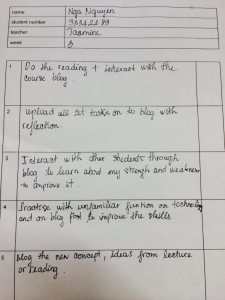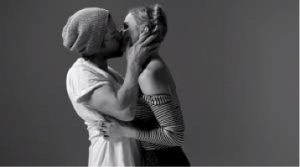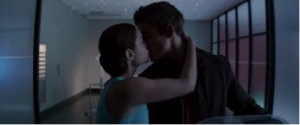Essay:
Our interactive K-Film, ‘Eyes – The Window to the Soul,’ is an exploration of the human eye. It explores how certain things can go unnoticed by the human eye, such as the clip with the bee in the spider web. It explores the nature of eyes in certain contexts, such as doing one’s makeup. It explores the inclination of eyes to lock themselves onto interesting things to in mundane settings, such as that of the men playing chess at the library. It explores how eyes are lured by technology, such as mobile phones. It explores how eyes can identify the emotions and personality of humans and of animals. It explores how the eye is attracted to movement, of transportation or of the surrounding environment. It explores how eyes can make us patient, through long shots of the sky or sunsets. It explores how the eye recognizes the relationship between light and darkness, with the clip showing the strobe light.
The aim of our Korsakow film is to force the audience to think outside the box, and consume the film in a personal way that only the individual can interpret and understand. “A narration’s structural patterns, rhythms and pacings can evoke feelings of boredom, arousal, calm, anxiety; encourage identification with the story world and investment in outcomes,”(Luers, 2013). Our film is a congregation of elements associated with the eye, from endless differing internal and external perspectives. At times, the film explores events and occurrences that can go unnoticed by the human eye. Events that the average human doesn’t spend time concentrating on. This film allows the audience to see a side of life they usually choose to neglect. Patterns are very significant throughout our film. The immense detail in the eye itself, contrasts significantly with pattern and shapes associated with objects the eye sees. This relates back to our overall subject. There is an enormous amount of detail in our footage of purely the eye, compared to our shots of objects the eyes sees, ultimately relating back to how important the eye is.
Our editing patterns are also extremely effective in how we want the viewer to feel whilst watching our K-film. We have deliberately included short, sharp and fast clips alongside slow, motionless and somewhat lifeless clips, again breaking any rhythm to allow for mixed interpretation. Another theme is the abstractness of the subject. In some scenes, we want the audience to look straight at the middle of the shot such as that of the eye themselves, whereas in others we wish to direct the viewer’s attention with the movements, such as that of the clip of the light bulb from its shadow. The significance of eye colour, and the difference in eye colour, is also important for our film. Each eye and eye colour tells a different story. Each eye has seen something different the next. Each has a story of its own, so therefore separating these by colour works really well for our film. We have also chosen to use a mixture of the same actors in our film, to build repetition and familiarity within it. As we have mentioned, we want out Korsokow film to be viewed a number of times, and for a different experience to be reaped each time, so therefore we need the audience to build a rapport and sense of trust and familiarity with our actors, hence why we haven’t included individual separate actors for each clip.
The exploration of our theme of all things the human eyes speaks well through our content in our K-film. “Many new media objects do not tell stories; they don’t have a beginning or end; in fact, they don’t have any development, thematically, formally, or otherwise, that would organize their elements into sequence. Instead they are a collection of individual items, where every item has the same significance as any other.” (Manovich, 2002 via Luers, 2013). Our exploration is achieved through an array of footage, some close up, some macro lense work and some long panning shots. The camera movements vary, from up to down, down to up, side to side, forward and back. We really enjoy the films use of close ups, specifically the close ups on the human eye of different individuals. We wanted to move away from showing just 60 clips of the human eye, as we felt it may get boring for the viewer. Instead we opted for an abstract exploration of not only the eye as a form itself, but also things that we see, and how these things can tell you so much about a person or a setting. The patterns of internal and external viewing of the eye interlace narrative through the piece, which is also achieved with a simple interface layout that works at not distracting the viewer with outside interruptions. “Narration is offered through the interface – the design and layout and linking specifically,” (Soar, 2014). Our Interface layout is one larger tile with three smaller tiles aligned together along the bottom. “However the interface is designed, the entry point prepares the user for interaction and most importantly the desire for interaction. They choose when and where to exit,” (Luers, 2013). This is a great statement form Luers, and one we used to guide us in SNU-fying our clips in order for the viewer not go bored too quickly making them want to navigate away from our film. By “Adding metadata to each short film including key-words, probability, lives, etc and then refining this assemblage based on repeated viewing and test screenings,” (Soar, 2014) we were able to create a connection between clips that may seem completely unrelated to the viewer. Also on the interface, our text thread sits above the main tile of the K-film. Our background image of the sci-fi like macro view of the eye ties our overall theme together.
We wanted the overall tone of the piece to be slightly somber, but not too dark or depressive. That is why we took the path we did with the text thread. The text thread was designed to continue with the theme of personal interpretation through the eye. These well thought out text threads were designed to be quiet poetic and abstract, while easily providing a platform for the viewer to interpret and connect personal experience, respectively. The text thread at times can portray a sense of depth to each clip, even clips that seem completely mundane. Each thread guides the viewer down a different path, again making the experience unique and different for each individual, and, for each time the respective viewer watches our Korsokow film, they will take a different journey dependent on their mood, previous experience and overall satisfaction with the film. The video clips, text thread and music work harmoniously together and help develop the pattern of our film. The ambient music works at creating a soft mood, which takes the edge off the text thread. The music continues to play whilst there is no clip selected, and there is no looping that is obvious to the ear, which is a positive. The sounds of soft crushing waves, seagulls and children playing help keep working to evoke emotion. We played around with turning the sound off on our individual clips, but we liked the atmospheric sounds of the clips in our K- film as we felt it helped the viewer to have more of a connection to each individual clip. During the editing process we also played around with moving some clips on a vertical angle, as a way to show that not everyone will see things in the same. Although this is a very literal move, we wanted it to be an abstract idea for the viewer to grapple with, wondering if it was done on purpose or not.
We took cue from some of Adrian’s comments in the lecture in developing our work. We found it very interesting how he addressed how humans naturally think about change, and how things should naturally change and be different all the time. He used the analogy of AFL and how you don’t watch one season then never watch it again. Letting go of control was hard for some of us as producers, but as Adrian addressed, “you don’t need a multimedia film if you are not going to let the audience have some kind of agency.” That for us was key in understanding how to let part of our control over creative vision go. We also wanted the audience to experience an emotion, which we found much more powerful than showing them. Having a theme was a good constraint for us, however we left the theme still slightly open and uninterrupted for the viewer by offering an explorative k-film rather than a definitive one.
“The list as a structuring device in creative screen based documentary is a formal approach that also speaks of the infinite possibilities in combining and making connections across a networked field of elements,” (Frankham, 2013). Through the use of lists we are making the problem of what’s it all about easer to solve. However, we understand as creators that our intent cannot preserve context or meaning for the viewer.K-films don’t require an ending in the literal sense – the rules of engagement are now very different. It is very interesting to see how far we have come in this course especially surrounding the idea of “endings”. Most of us agreed at the beginning of this subject K-films were slightly confusing because of the lack of ending, but this subject has taught us as humans that not everything has to have a finish or be as we expect, which in-turn helped us in creating our final K-film. We now find K-Films to be a great and interesting medium for film, one that we would like to try our hand at again.
REFERENCES
Frankham, Bettina Louise. “Complexity, Flux and Webs of Connection.” A Poetic Approach to Documentary : Discomfort of Form, Rhetorical Strategies and Aesthetic Experience. (2013): PhD Dissertation, University of Technology Sydney.
Luers, Will. “Plotting the Database.” Database | Narrative | Archive: Seven Interactive Essays on Digital Nonlinear Storytelling. Ed. Matt Soar and Monika Gagnon. N. p., 2013. Web.
Soar, Matt. “Making (with) the Korsakow System: Database Documentaries as Articulation and Assemblage.” New Documentary Ecologies Emerging Platforms, Practices and Discourses. Ed. Kate Nash, Craig Hight, and Catherine Summerhayes. Palgrave Macmillan, 2014. 154–73. Print.




